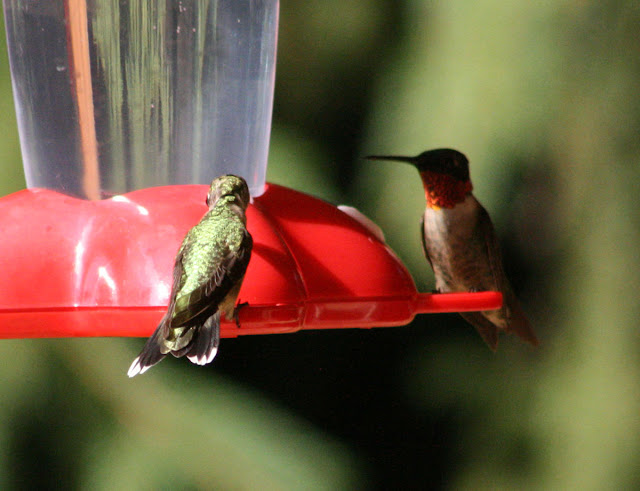There's some cold air moving into east Tennessee right now with steady rain through last night and this morning. I'm located in the Tennessee Valley on the edge of the Great Smoky Mountains. It's amazing how different 60 degrees F can feel when its accompanied by rain and wind. Without a doubt, our hummingbirds are feeling it too. (Click images to enlarge)
Just two days ago, I spent most of the day outside on a sunny, breezy, short-sleeved day. Sometimes Ruby-throats pulled me out the door with their wing buzzing and shrieks. A dozen or more had descended upon the feeders, arriving in waves, ahead of the rain. Another time it was the Pileated Woodpecker family with the male announcing their arrival. And once you're out the door, anything can happen.
But I'm devoting most of this post to a hummingbird juvenile, one who endeared himself to me far more than I expected. I noticed him a day earlier, perched on the stem brace in a flower pot on the patio--the flower pot positioned just below
his feeder and only a few feet from my door.
I saw my last male Ruby-throat on September 19th. According to Bob Sargent, a leading hummingbird specialist, the females usually follow the males within about ten days. The majority of birds we are seeing now are juveniles, with a few late-nesting females. That change in population make-up has dramatically altered the feeder dynamics. I still see all the threatening displays, scolding, chasing, beak biting and body slamming, but there are also some peaceful periods in between. Below you see a battle image that made me shudder.
Challenged by the fact that I was hearing clashing sounds--'splats', I called them--like wings or beaks striking, and also that I saw one hummer land on another's back through my lens, I became determined to capture a few action images, no matter how blurred, to confirm for myself what kind of contact was happening.


I'm showing you these images to round out the picture and dispel any doubt about whether hummers are sweet. They may look sweet, but behaviorally, they are not. And they do get injured. Feathers are stripped off, skin is exposed, and strike wounds appear. It's a bit reassuring that they all have speed, long beaks, and for the most part are among peers this time of year, so the field is relatively level. Experience and superior genetics seem to make the difference in who prevails. But while watching these juveniles, my heart tugs as I quietly gasp at their relentless aggression. Despite all the 'hoodlum' antics and ambushes, this is necessary training for survival. Only 20% of this year's juveniles will survive to reach their first year milestone.

This juvenile male you see above was particularly mean or stealth, as we might call it. In comparison to the other juveniles who flared tails, chirped and gave warning, he slammed unsuspecting birds relentlessly during his stay. In my mind, I alternately called him, Calico and Mr. Bad, cringing at some of his attacks. I believe all that color under his chin is his emerging gorget feathers but it's hard to tell. Here's another view of him below from a different angle.
But now I want to show you the sweet moments, the ones that endear these birds to us, capture hearts, and guarantee attachment. Below you see the flower child. He not only guarded the feeder but incorporated the flowers below it into his territory, swinging down to sip nectar as he returned from chasing intruders.
And here is what was so different. He and another juvenile guarded their nectar source from the top of the feeder, the feeder perch itself, and from perches below it, all places of disadvantage in the presence of more experienced birds. At the top of their form, males in my yard typically perch twenty or more feet away, giving opportunity for steep, high-speed dives and unquestionable dominance. After seeing that kind of action, these late juveniles, no matter how fierce their intent, seemed endearingly naive by comparison.
As much as watching his behavior at such close range, a distance of about seven feet, what endeared him to me even more was his acceptance of my presence. Neither the clicking of my camera nor my movement in and out the door stirred more than a casual turn of his head to see what I was up to. And yes, despite all the mean-tempered combat I've witnessed, I still call them 'sweet'. Oh my, will I ever miss them when they're gone!
To see more of my blog posts about hummingbirds visit
Ruby-throated Hummingbird Migration and
Hummingbird Banding. And you may enjoy reading
Hummingbirds and Sea Turtles to see what brings these two species together for me while creating art.
Reference for the latest on hummingbirds:
Hummingbird Study Group .









































